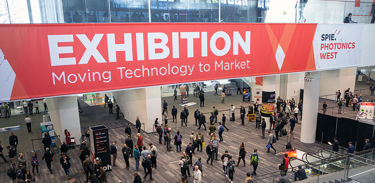Finally Face To Face Again At Photonics West

By Abby Proch, former editor

Photonics West 2022 offered what much of the photonics and optics community has been needing: face time.
No, not that kind. The much-anticipated gathering cultivated real, live interaction that just can't be replicated on a Zoom call.
Warm and welcoming, the conference and its plenaries, exhibitions, and chance conversations were a shot in the arm to what's been a disconnected and disconcerting past two years. Although SPIE won’t be releasing attendance numbers till later in the week, SPIE Senior Director and Photonics West Event Manager Marilyn Gorsuch raved about the in-person experience.
“It was a pleasure to interact with our attendees, volunteers, and exhibitors in person after a two-year hiatus. We particularly relished witnessing those face-to-face conversations and serendipitous meetups in the conference hallways and on the exhibition floor,” said Gorsuch in a statement. “By adhering to national and local health guidelines, the photonics community at Photonics West could safely focus on the business at hand, engage with exciting new research, and make those critical, in-person connections.”
I second the sentiment. Having been at the helm of Photonics Online for just six months, Photonics West offered all of the opportunities I just couldn’t manifest from my desk. Stopping by the G&H booth led to a better understanding of the challenges facing lidar for remote sensing, from overcoming transmission (stability and scope) and reception (power needs and signal impairment) hurdles to dealing with atmospheric impacts when used in space. Regrouping at my own booth put me in the perfect spot to meet an epoxy manufacturing rep, someone I’d probably never meet in my everyday work. And zipping straight from my hotel to the plenary talk by Tammy Ma of the Lawrence Livermore National Lab’s National Ignition Facility (NIF) exposed me to the incredible intricacies and vastness of the laser lab that’s able to coerce the nuclear fusion of hydrogen isotopes in the quest for clean energy.
Incredibly — the size of three football fields — the NIF boasts 192 laser beams that pinball around toward a tiny, dense pellet containing hydrogen isotopes, deuterium and tritium. When fired, the laser reconvenes on the pellet within billionths of seconds for a short-lived but incredibly powerful moment of nuclear fusion. In August, the NIF bested its previous output by producing 1.35 megajoules of energy. Though still not enough to offset the 1.9 megajoules needed to initiate the process, it gave a 71% return, scores better than the NIF’s previous record of 9%.
Looking ahead, Ma’s hoping for improvements in large aperture optics that make the glass better able to withstand high temperatures (100 degrees C, at times) and to boost laser power, as well as a transition to color laser diode pumps that offer cooler, more efficient laser beams. While nuclear fusion research and experimentation has been ongoing for nearly 60 years, Ma is optimistic that breaking even, or obtaining a “gain of one,” will be attainable in just a few years.
This is a time when the world is scrambling to lower emissions that contribute to climate change, and the prospect of clean energy couldn’t be more exciting — which is one reason I was a little bummed I missed the “Photonics for Net Zero” talk.
The good news is that SPIE offers a baffling depth of resources and reporting to supplement one’s experience. The Wednesday morning write-up did a sufficient job of covering a topic I didn’t want to miss. Suffice it to say data centers are the “new oil,” and photonics — through shortening the distance between optical switch transceivers and central processing chips, swapping single mode silicon for multimode VCSELs in machine learning systems, and even relocating data centers to cooler climates —is here to stave off effects akin to those of fossil fuels.
Just as important as the learning opportunities were the connections I made as I walked the show floor. At NIL Technology, Daryl Lafleur and Niklas Hansson showcased a 2.5mm metalens that relies on meta-atom structures created by nanoimprint lithography to phase light with up to 95% efficiency. The temperature-tolerant optic competes in performance and cost with refractive lenses, all while cutting down on integration, assembly, and alignment issues that can plague NIR multi-lens camera systems, say the two.
And over at Pleora Technologies, Ed Goffin demoed its AI-based Visual Inspection System that, in one application, helps factory workers accurately hand-place labels on Dairy Distillery vodka bottles. The imaging system with AI plug-ins can be trained to customers’ specific requirements to assist in quality control and inspection measures. The solution marks a new direction for Pleora, which has added the AI inspection system to a repertoire that initially featured Camera Link to GigE Vision converters.
The days were packed to be sure. But I feel there was still room for more. Next year, I’m eyeing the Startup Challenge. I didn’t get around to attending this year, but even the excitement in the press coverage is palpable. (VitreaLab, Quantopticon, Luminess took home top prizes for their work in laser-lit displays in 2D/3D, simulation software for quantum photonic hardware manufacturers, and safer and more sensitive X-ray imaging, respectively.)
While now is the time to put your business cards back in the drawer, the intrigue of Photonics West is not over yet. Photonics West On Demand is coming Feb. 21-27. The online platform will allow users to access research in biomedical optics, biophotonics, industrial lasers, optoelectronics, microfabrication, MOEMS-MEMS, displays, and more. Details are scant, but the offerings will surely help keep the momentum going from the in-person event — not that we need it. The Photonics West buzz can certainly keep us churning for a little while, perhaps until Defense + Commercial Sensing in April?
